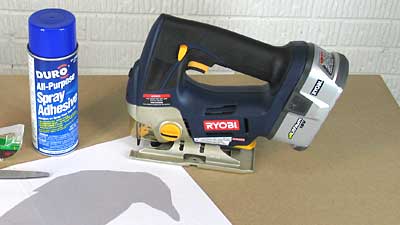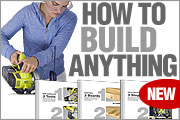
Ryobi 18v Lithium-Ion Cordless Jigsaw
There are a lot different jigsaws available that will easily do the job of cutting out patterns from 1/4" sheet goods. For now, I'm using the Ryobi cordless, mostly because I needed a jigsaw that would work with the Ryobi battery and charger that I already own.
One thing I like in particular about this style of jigsaw is the laser beam - which does a nice job of letting you know where your cut line is. That's a handy feature to have, especially when cutting MDF. What I noticed about cutting MDF is that it creates a lot of dust that quickly covers up whatever template line you've drawn on the board. The laser seems to cut through all that debris and help me keep on line - without having to stop every 15 seconds and blow away the dust!
Who Needs a Jigsaw?
When it comes to cutting twists, turns, and curves in wood, the jigsaw is hard to beat for its low cost and ease of use (you’ll spend only fraction of what you would pay for its close cousins—the scroll saw and band saw). In fact, it’s so easy to use that you might forget that this tool cuts through fingers just like any other power saw (just a safety warning). But with a nice, tight grip on the handle and the proper set up (boards secured and clamped to a sawhorse or bench), using a jigsaw can be fun and easy.
Top 3 Mistakes Made When Using a Jigsaw
1. Wrong Blade
A jigsaw works great—if you have the right blade installed for the job. The wrong blade will bring your jigsaw down to a frustrating, slow and battery-draining grind. Take the time to switch blades when switching between different materials and you’ll do both you and the saw a favor.
2. Pushing Too Hard
It’s easy to get impatient with a jigsaw and try to speed up the cut by pushing forward. This causes more trouble than it solves. Even a small amount of forward pressure can make the blade bend—creating a small bevel to the cut. Worse yet, the extra pressure can cause a blade to snap.
3. Pinching the Blade
When cutting large sheets of thin material, the weight of the saw can cause a sheet to bow and sag in the middle—making the material collapse against the blade. This can cause the saw to stop, stray off path, or worse, jump dangerously up and away from your workpiece.
Know These Jigsaw Controls
Trigger Switch
Like most saws, the jigsaw includes a safety-lock feature that keeps you from picking up the saw and accidentally starting the the blade.
Orbital Control
This controls the cutting pattern of the blade, which can be adjusted to better match the material you are cutting. This is crucial for cutting thin laminates.
Bevel Adjustment
Probably not something you’ll use very often, but nice to have when you need it. Use an angle gauge tool for setting precise bevel cuts. |



